Waterproofing an Old Wood Foundation
I’m seeking advice and experiences with damp proofing (or waterproofing) methods for an older PWF basement that has been subject to localized water ingress due to poor site grading and roof drainage. The home is 40 years old, in climate zone 7A (BC, Canada), however we see some winters more like zone 6. The original damp proofing appears to be an asphaltic brush/spray on product with no poly sheeting or sacrifical plywood plate at grade. The structure is a fully developed basement, backfilled to approx. 5ft, 2×6 PWF construction, insulated with R20 fiberglass batts, a light vapour barrier (not 6 mil), and drywall interior finish. The water ingress appears to be from surface water ponding and seeping through the sheathing at both the vertical corner and horizontal sheet joints around the effect back corner of tge home where ponding on frozen ground has been occurring. Initial interior inspection with drywall removed in the fall observed dampness over entire sheathing surface below grade, but the insulation wasn’t saturated and no signs of mould on drywall and vapour barrier was intact. Pulling drywall and insulation up to above grade and observing multiple rain mid-winter rain events indicates joints in sheathing at or just below grade to be the ingress points, and the perimeter drain appears to be working to drain accumulated water in the wall cavities to the perimeter drain sump (located within the basement).
I’ve read various approaches for remediation of PWF systems, as well as the various new construction guidance/standards, but am still left confused on what the best methods would be for my specific situation/problem. As the sheathing appears to have been originally glued and nailed/screwed with potentially galvanized fasterners I’m hesitant to excavate more of the foundation perimeter than necessary to address the what appears to be a locaized surface water issue.
As well as damproofing and joint repair, I’m also considering an underground roof membrane to help direct and surface water to a swale that will collect the multiple downspout discharges from this side of the home and run to the front of the property. The problem corner of tge foundation is only 5 ft from the property line, so there isn’t much space for significant sloping and long leaders on the downspout at this location, but there is good elevation to work with to convey water to the front of the property from this back corner of the home.
My specific questions would be;
1. Is a peel and stick waterproofing membrane feasible (w.r.t proper adhesion) onto a 40 year old PWF sheathing substrate, versus a spray on rubberized membrane product or asphaltic product?
2. Knowing there will likely be continued moisture/humidity buildup within the wall cavities from soil moisture, is waterproofing the real objective for the proposed localized repair, or is dealing with the leaking joints and a damproofing method more realistic?
3. What are the better approaches for restoring the insulation, vapour barrier and airtightness in this one corner (a spare/guest bedroom) of the basement on a 2×6 wall?
I’ve included some photos that may help visualize my issues and the existing/original construction.
Any and all opinions are welcomed, and thank you in advance for your time and insight.
Regards,
Jason
GBA Detail Library
A collection of one thousand construction details organized by climate and house part


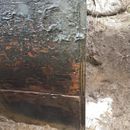
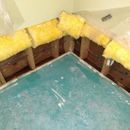
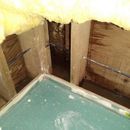
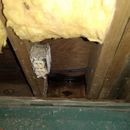
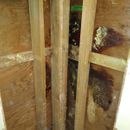







Replies
Here are some additional photos pf the historical ponding/grading issues creating the water ingress.
Thanks,
Jason
You absolutely must get that water away from the house. It would be inconvenient in a concrete foundation / basement, but not severe. If you don't have fall to get the water out of the way, you may need to rely on an active system to pump it away. Exterior sump basins are a method that you could use to collect it, and send it to the road. It's not as good as proper sloping, soils, and drainage, but it's the next best thing. It doesn't require much excavation, except for where the basin goes, and the pipes that collect the water.
Treated or not water plus wood equals rotten wood given enough time.
To my eye the exterior photos tell a frighting story. From what I can see that water has no where to drain to.
Seems to me if you can’t drain the water away the future is grim.
Walta
Thank you for your initial suggestions, I expected those ponding photos would raise a response. The design of the re-grading is well developed and will definitely remove the bulk of the water that has ponded at the lowest point (at the corner of the foundation!). The lot luckily has enough fall to run a decently sloped swale and create positivegrade away from the foundation.
The above said, I want to make sure any residual surface water, or overflowing eavetrough events are prevented from creating a hydrostatic pressure condition on the foundation, which is likely a larger risk when we get a big winter rainfall event on frozen ground. Therefore Im very interested in the success others have had at remedial waterproofing or damproofing older PWF and if there is a preferred approach for colder climate zones. Any suggestions or experience would be greatly appreciated.
That great news from the photos it would seem to be a miracle to fine that much fall on your site.
Maybe the people that like the PWF idea will post something helpful but I am not a fan.
Seems to me a PWF is more or less unrepairable once the building weigh is on the foundation the question is must it be replaced now or can we wait.
Walta
Thanks Walta, I appreciate the responses!
Thanks Walta for your time and suggestions. Hopefully those that have PWF remediation experience share their insights, as it seems to be a bit vague as to best practices for waterproofing (or damproofing) the treat wood substrate, especially when it's beed buried for decades.
Regards,
Jason
North, from the pictures you have two things to address, and you're already aware of them!
-Remove the standing water - you have some plans there
-Re-seal the foundation - Given it's already an asphaltic product, I think it best to stay that way. Bituthene may be a good option for that. Looking at the pictures, I think exposing the whole foundation, pressure washing, letting dry, priming and using Bituthene or another asphalt coating, then add dimple mat to relieve hydrostatic pressure is what I would do. https://gcpat.com/en/solutions/products/bituthene-post-applied-waterproofing/bituthene-4000-membrane
Thank you hockipuck, this is the knowledge I was hoping to tap into! I only want to dig this up once, so want to do it right, or as good as possibel given the age. I appreciate your time and sharing.
Thanks,
Jason
I don’t want to be throwing stones but I think having a machine dig out a concrete foundation would be a risky call with an above average operator.
To my ear machine digging a wood foundation sound like mission impossible and hand digging given the local frost depth also sounds equally impossible.
Does anyone think exposing a 40 year old wood foundation is prudent or possible?
If you do dig, have plan made in advance for what amount of damage will trigger a full replacement?
Seems to me the plan should be to deal with the water and hope for the bests. If and only when it is clear the foundation is no longer sound replacement would be the plan.
Walta
Thanks Walta, that is definitely a signififcant consideration, making the problem bigger by disturbance or damage. I've been leaning towards a shallow dig to just address the grading/drainage, and maybe seal the joints in the top 2 ft rather than excavating to the footing and risking damage either during excavation or backfill. It would be great to hear from those that have attempted (sucessfully or not) a similar repair.
Have dug successfully several times and found surprising good shape despite similar situation. The grading is definitely very important but so is sealing exterior. Use proper primer and membrane combination and dimple board for drainage and while down there address drainage at base and gravel is your best friend. never worry again.
Thank you foundationpickles, that is great to hear and get your input on what has worked! The primer was a question I had as some people use it and other have said just pressure wash and dry before applying the membrane. Are you in favour of a peeel and stick membrane or a liquid product?
Hi, I am also in BC 7A, neighbours?
I would look to excavate the entire perimeter, damp proof with peel and stick or similar, place foundation drainage piping and backfill to the top with drain rock. The foundation drainage piping can be put into a sump and pumped to wherever, or tied to town storm if possible.
The sump should have a high level alarm, and you should be able to run it off of a generator if the power goes out in a bad storm.
As mentioned, you will need a skilled operator to excavate safely, but the machine could do the bulk of the work and leave the soil that is very close to the foundation to be excavated by hand. Get a crew of young fellas to help out. Do 1 wall at a time, from start to finish. Hopefully you will find the foundation to be in good shape as you expose it.
I think to do anything else is not going to fully address the problem.
Good luck!
Thank you plumb_bob, great suggestions and I really want to do this right and not twice. If you see a basement being dug up this June, stop in to ask how it is going!
Thanks,
Jason
Oh, I remember when my family and I moved to another state because the company offered me a long-coveted management position. That company provided my family and me with a home. This house was in the category of houses that are old but also very well kept. Everything about it was perfect except for the backyard. The backyard was dirty, and my wife and I realized we couldn't do without a pressure washer. So we turned to the guys at https://sparklewash.com/pugetsound. While washing the yard and partially the house's walls, we found water flows into the foundation. Then we just concreted all the cracks.
Others have made good suggestions. Fix the grading issue first, then address the waterproofing. I would add that once you've exposed the outside of the foundation, you have a great opportunity to add exterior draining insulation which gives the added benefit of hydrostatic pressure relief (belt and suspenders for the waterproofing effort). There are fiberglass and mineral wool type boards for this. Warm-n-dri comes up mind. There's also grooved XPS or EPS but I have less confidence in those -- I believe they need to be paired with a dimple mat.